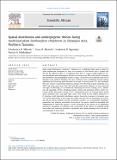| dc.description.abstract | Knob wood (Zanthoxylum chalybeum - Rutaceae) is a medicinal plant species subject to heavy exploitation throughout its areas of occurrence in Sub-Saharan Africa. Despite that the tree has different values as a traditional herb, there is a gap in understanding its current distribution and anthropogenic threats in its range areas. This study aimed at mapping the distribution and anthropogenic threats facing Z. chalybeum tree in different land uses of Simanjiro area, northern Tanzania. The rates of threats such as debarking, branch cutting, uprooting and harvesting were observed to be high in grazing lands (GL) and farmlands (FL) (73% and 62% respectively) while least threats were observed in game controlled areas (GCA) and game open areas (OA) (39% and 40% respectively). Majority of trees observed had signs of debarking (51%) followed by debarking and branch cutting (20.6%), debarking and uprooting, (15.8%), debarking, branch cutting and uprooting (4.76%), whole tree cutting (4.76%) and branch cutting (3.17%). Conservation areas (i.e. hunting blocks within game controlled areas and game open areas) were found to have higher abundance of Z. chalybeum with detectable distribution pattern than other locations in Simanjiro area. The current observation in this study also shows that the rates of harvesting are increasing and harvesting methods used by community members are unsustainable. Regulatory approaches that promote sustainable harvesting of the species should be developed and implemented to reduce the impacts of over harvesting of the species on its population persistence. Promotion of cultivation and conservation of the species in farmland would help reduce the harvesting pressures in protected areas while providing access by the local community in their farms. | en_US |

